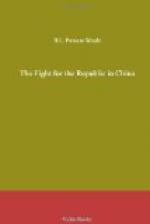In the Autumn of 1908 she took sick. The gravest fears quickly spread. It was immediately reported that the Emperor Kwanghsu was also very ill—an ominous coincidence. Very suddenly both personages collapsed and died, the Empress Dowager slightly before the Emperor. There is little doubt that the Emperor himself was poisoned. The legend runs that as he expired not only did he give his Consort, who was to succeed him in the exercise of the nominal power of the Throne, a last secret Edict to behead Yuan Shih-kai, but that his faltering hand described circle after circle in the air until his followers understood the meaning. In the vernacular the name of the great viceroy and the word for circle have the same sound; the gesture signified that the dying monarch’s last wish was revenge on the man who had failed him ten years before.
An ominous calm followed this great break with the past. It was understood that the Court was torn by two violent factions regarding the succession which the Empress Tzu-hsi had herself decided. The fact that another long Regency had become inevitable through the accession of the child Hsuan Tung aroused instant apprehensions among foreign observers, whilst it was confidently predicted that Yuan Shih-kai’s last days had come.
The blow fell suddenly on the 2nd January, 1909. In the interval between the death of the old Empress and his disgrace, Yuan Shih-kai was actually promoted to the highest rank in the gift of the Throne, that is, made “Senior Guardian of the Heir Apparent” and placed in charge of the Imperial funeral arrangements—a lucrative appointment. During that interval it is understood that the new Regent, brother of the Emperor Kwanghsu, consulted all the most trusted magnates of the empire regarding the manner in which the secret decapitation Decree should be treated. All advised him to be warned in time, and not to venture on a course of action which would be condemned both by the nation and by the Powers. Another Edict was therefore prepared simply dismissing Yuan Shih-kai from office and ordering him to return to his native place.
Every one remembers that day in Peking when popular rumour declared that the man’s last hour had come. Warned on every side to beware, Yuan Shih-kai left the Palace as soon as he had read the Edict of dismissal in the Grand Council and drove straight to the railway-station, whence he entrained for Tientsin, dressed as a simple citizen. Rooms had been taken for him at a European hotel, the British Consulate approached for protection, when another train brought down his eldest son bearing a message direct from the Grand Council Chamber, absolutely guaranteeing the safety of his life. Accordingly he duly returned to his native place in Honan province, and for two years—until the outbreak of the Revolution—devoted himself sedulously to the development of the large estate he had acquired with the fruits of office. Living like a patriarch of old, surrounded by his




